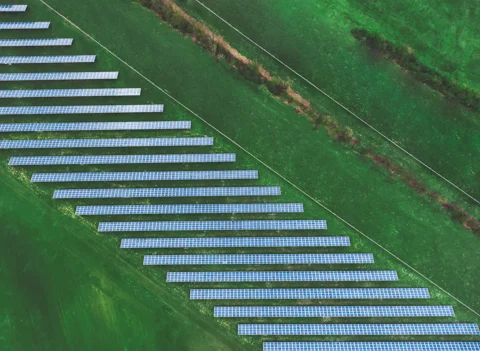Hotels, rental properties, wind farms, airports, parking garages; APG has invested a lot in 2019 in Real Assets (tangible investments) as they call it at Asset Management. Patrick Kanters, Managing Director Global Real Assets, expects this trend to continue in 2020. He also hopes to gain more foothold in the Netherlands.
Based on the many reports, the share of Real Assets in APG's portfolio seems to be growing. Is that correct?
“Yes, it is. Our largest customer, ABP, strives for a growth of 2 percentage points of the total Real Assets portfolio; 1 percent for real estate and 1 percent for infrastructure. In addition, an expansion of the Natural Resources portfolio is pursued through investments in forestry and agricultural lands. That seems quite modest at first glance, yet we’re talking about approximately 10 billion in total expressed in money. We witness a market trend of increasing investments in Real Assets. The share of direct investments has been growing at APG since 2010 as compared to investments in funds.”
What is it that makes these types of direct investments so attractive?
“First of all, we are able to save significantly on costs. When investing in funds, a lot of money is charged for fund management. And besides that, direct investments provide more control over the type of investment we make. Does it fit within the return and risk profile we envisage? Does the investment meet our investment beliefs? It also provides us with an opportunity to have a greater say in strategic decisions. How much borrowed capital will be allocated to underlying investments, what sustainability requirements do we impose?”
How high is the return on Real Assets?
“The return on real estate and infrastructure has been more than 9 percent on average in the past 15 years. This in combination with the diversifying role against stocks and bonds ensures for it to be an attractive investment. Of course, we notice it has been getting increasingly easier to acquire borrowed capital for investments in real estate and infrastructure, due to the current low interest rate. As a result, the prices, in addition to a strong demand for higher returns, have risen sharply. Expectations for the future are therefore more moderate and the situation may arise in which returns on investment we estimated no longer counterbalance our required returns.”
What are the risks of this investment category?
“In real estate, for example, we have to consider the economic risk of vacant buildings. When it comes to infrastructure, the fees of toll roads and the number of passing moves of drivers may influence the return. But within infrastructure we also receive income that is less depending on the economy, such as fixed fees for maintenance and provision of infrastructure. In addition, we often conclude long-term regulated contracts with governments and semi-governments. Those parties are often very reliable.”
What other criteria does a Real Asset have to meet for it to become interesting for APG?
“An investment, first of all, must have a sufficient volume. To give an idea, we focus on interests in real estate and infrastructure with a minimum of around 200 million Euro. Should an investment opportunity come along with less volume, we have to be convinced the investment can be scaled-up in the near future. CitizenM is a good example of such investment. We have partly built that hotel chain from the ground up into a large platform. The governance of a company is also important. Do we, as an investor, get a vote to block, for instance, the addition of new real estate objects and greater use of borrowed capital? Sustainability also is an important criterion. Every investment has to participate in the so-called annual GRESB-survey (sustainability benchmark for Real Assets). It will have two to three years to perform above average in terms of sustainability.”
So, the scale of APG works to your advantage in this case.
“Absolutely. We belong to the three largest asset owners worldwide within real estate. We are meanwhile part of the top 6 for infrastructure. That scale provides us with the opportunity, as said, to influence the strategy. In addition, our scale allows us to develop new markets and to improve innovative investments.”
What type of markets are you talking about?
“Take the rental properties in England. Eight years ago, a professionally operating rental housing market barely existed. We have approached some parties there and co-established platforms that started to specialize in this real estate segment. That’s how we gained a foothold in that region. Another example are outlet centers, large shopping malls selling the brand collection of last season with substantial discounts. That’s a growing market attracting many tourists as visitors. However, it’s not a real estate category that just falls into your lap as an investor. Thanks to our scale, long-term focus and reputation, we gained access to the best specialized parties. Without our scale and accumulated expertise, we would never have been able to invest in this category.”
Besides the role of investor, you also fulfil the role of developer?
“The role of our teams at Asset Management has indeed changed significantly in the past years. Where the focus previously was on the stones (the location and quality of the building itself), it becomes increasingly important what actually happens to those stones. Do the activities taking place within a certain type of real estate align with a certain trend or market need? How does the management distinguish itself? In which way could smart technology contribute? Those questions are becoming more and more relevant. The intangible value of Real Assets is making an increasingly large mark on the return.”
Does that also require a different role for your team?
“Yes, it does. More entrepreneurial, closer to the business, being able to make more rapid decisions. More is required from us, but, at the same time, the work has also become more interesting. Fortunately, there’s room to hire new people. We will recruit 8 employees at infrastructure and 5 employees at real estate this year.”
Don’t these additional personnel costs have a serious effect on the return?
“When you look at the overall picture, it is actually more cost-effective. It is way cheaper than spending money on a fund manager. On balance, we have noticed a major decrease in the investment costs of our customers.”
What are your expectations for 2020; what are the interesting sectors for APG?
“Renewables such as wind and solar parks continue to be interesting in relation to infrastructure. However, the sharp increase in prices could possibly change that somewhat. We furthermore consider telecom an interesting sector because of the growth in data traffic. The growing electrification, in cars for example, also makes us consider electricity networks as an interesting investment. In real estate, distribution halls are interesting because of the growth in e-commerce and we continue to focus on the development of rental properties and student residences.
In the past year, APG has mainly made infrastructure investments abroad. Is the Dutch market not interesting enough?
“On the contrary. We would be happy to invest more in the Netherlands. What is difficult in the Netherlands, however, is that much infrastructure is fully owned by the government. When Eneco was offered for sale, we considered taking a stake, but eventually decided not to. Through the energy transition fund ANET we will invest in relatively small and innovative companies committed to the transition to sustainable energy. We also see opportunities to gain a foothold in the Netherlands in other sectors, such as telecom and wind farms.”



